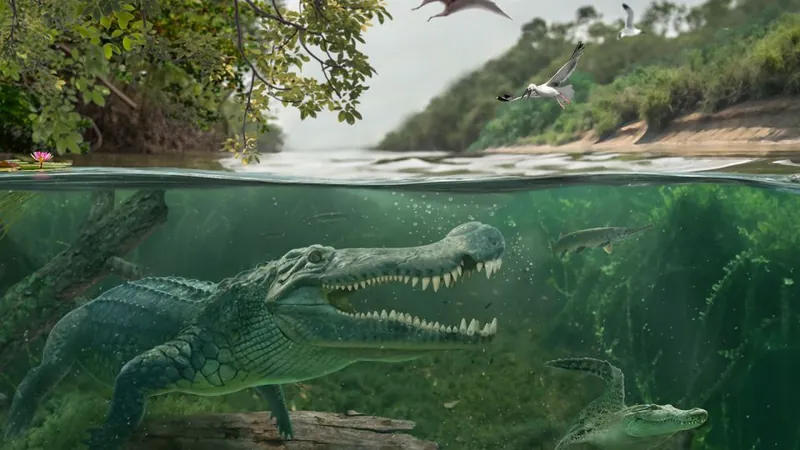
Uncovering the Secrets of the Terrifying 'Terror Crocodile': Why Deinosuchus Became a Dinosaur Slayer!
2025-04-25
Author: Chun
Meet the Terrifying Titan of Ancient Waters
Imagine a colossal reptile that roamed the rivers of North America, feasting on unsuspecting dinosaurs! Meet Deinosuchus, or the terrifying 'terror crocodile,' which thrived between 82 million and 75 million years ago. This ancient predator boasted a body nearly the length of a bus and teeth reminiscent of bananas, making it one of the largest crocodilians to have ever lived.
Success in Unusual Waters
What set Deinosuchus apart from modern alligators was its remarkable ability to thrive in saltwater environments. Research published in *Communications Biology* reveals that its unique salt glands enabled it to effortlessly navigate the vast Western Interior Seaway—an ancient body of water that split North America. While alligatoroids shied away from salty waters, Deinosuchus could explore coastal marshes across the continent, hunting down massive prey.
The Evolutionary Enigma Unraveled
For years, scientists believed Deinosuchus belonged to the alligator family. But a groundbreaking analysis combining fossil evidence and DNA from living relatives reshaped that view. It turns out, this giant didn't just happen to look like an alligator—it was an entirely separate branch of the crocodilian family tree!
Navigating a Changing Ecosystem
With its ancient salt-tolerance trait, Deinosuchus had the ecological flexibility to adapt during drastic climate changes. Dr. Márton Rabi, a leading researcher, highlighted the ecological dominance of this predator, stating, "No one was safe in these wetlands when Deinosuchus was around." Imagine wading through marshes where a 26-foot-long behemoth could be lurking!
The Mysteries of Distribution
Fossil evidence shows that Deinosuchus thrived on both sides of the ancient seaway. The question lingered: if it was an 'alligator,' how could it cross the more than 620 miles of salty water? New findings suggest that saltwater adaptation wasn’t lost in evolution but rather represents an ancient trait of many crocodilians. This capacity allowed them to survive when other species perished.
Not Just a Mythical Giant
While Deinosuchus was staggering in size, it wasn’t alone in the arena of giant crocodilians! Researchers discovered that massive crocs have appeared independently in various aquatic environments throughout the last 120 million years. It seems giants like Deinosuchus were the rule rather than the exception in the prehistoric world.
A Window Into Prehistoric Adaptation
This new research enriches our understanding of not just Deinosuchus, but the entire crocodilian lineage. As climates shifted and environments changed, species like Deinosuchus adapted and thrived, proving that adaptability is key to survival. Dr. Evon Hekkala noted, "This gives us insight into how ancient crocodile relatives navigated harsh environmental shifts." The tale of Deinosuchus isn't merely about being a fearsome predator; it's a story of evolutionary survival and resilience amidst the ever-changing tapestry of Earth's history.





 Brasil (PT)
Brasil (PT)
 Canada (EN)
Canada (EN)
 Chile (ES)
Chile (ES)
 Česko (CS)
Česko (CS)
 대한민국 (KO)
대한민국 (KO)
 España (ES)
España (ES)
 France (FR)
France (FR)
 Hong Kong (EN)
Hong Kong (EN)
 Italia (IT)
Italia (IT)
 日本 (JA)
日本 (JA)
 Magyarország (HU)
Magyarország (HU)
 Norge (NO)
Norge (NO)
 Polska (PL)
Polska (PL)
 Schweiz (DE)
Schweiz (DE)
 Singapore (EN)
Singapore (EN)
 Sverige (SV)
Sverige (SV)
 Suomi (FI)
Suomi (FI)
 Türkiye (TR)
Türkiye (TR)
 الإمارات العربية المتحدة (AR)
الإمارات العربية المتحدة (AR)